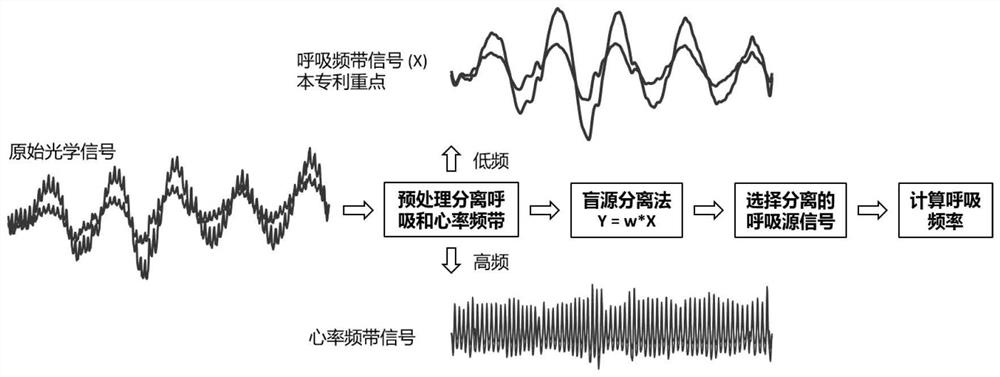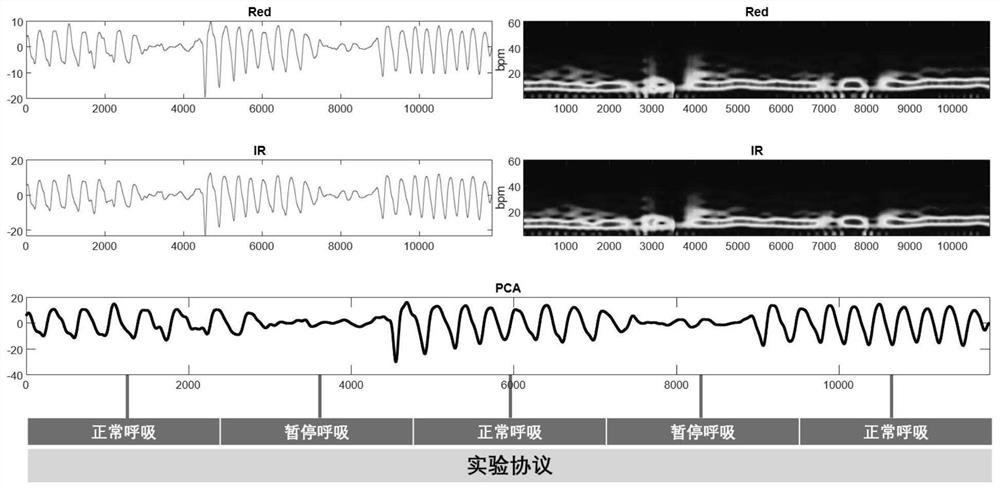Respiration rate monitoring method and device based on multispectral PPG blind source separation method
A blind source separation and monitoring device technology, which is applied in the use of spectral diagnosis, evaluation of respiratory organs, diagnostic recording/measurement, etc., can solve problems such as large errors and complexities, and achieve the effect of simple algorithm, improved stability, and improved signal quality
- Summary
- Abstract
- Description
- Claims
- Application Information
AI Technical Summary
Problems solved by technology
Method used
Image
Examples
Embodiment 1
[0058] See figure 1 , figure 1 It is a flow chart of the respiration rate monitoring method based on the multispectral PPG blind source separation method of the present invention. The respiration rate monitoring method based on the multispectral PPG blind source separation method generally includes the following steps:
[0059] S1, synchronously collect individual multispectral PPG signals, the multispectral PPG signals at least include PPG signals of two bands, such as red channel (660nm) and infrared channel (940nm).
[0060] S2, perform simple preprocessing on the original multispectral PPG signal obtained from the optical sensor, such as filtering, separating low-frequency signals (respiratory components) and high-frequency signals (heart rate signals).
[0061] S3, extracting the respiratory signal from the PPG signal containing at least two bands by means of multi-channel fusion. The multi-channel fusion method specifically adopts the blind source separation algorithm...
Embodiment 2
[0080] See figure 2 , figure 2 It is a structural block diagram of the respiratory rate monitoring device based on the multispectral PPG blind source separation method of the present invention. The respiration rate monitoring device based on the multispectral PPG blind source separation method is provided with:
[0081] Multi-spectral PPG sensor 1: The multi-spectral PPG sensor 1 supports at least two bands (for example, red and infrared bands), and is used to collect PPG signals with at least two channels.
[0082] Computing chip 2: used to perform computing tasks.
[0083] Preprocessing module 3: used to perform simple preprocessing on the original multispectral PPG signal obtained from the multispectral PPG sensor 1, such as filtering, separating low-frequency signals (respiratory components) and high-frequency signals (heart rate signals).
[0084] Respiratory signal extraction module 4: for extracting respiratory signals from the low-frequency respiratory components ...
Embodiment 3
[0091] A healthy adult volunteer was recruited, and a multi-spectral PPG sensing device (including two band signals: red band (650nm) and infrared band (940nm)) was used to fix it on the chest of the volunteer. Three different experimental protocols were used to verify the feasibility and sensitivity of multispectral PPG monitoring respiratory signals. Experimental results such as Figure 3-5 shown. Each figure contains the PPG signal (respiratory frequency band [0,30] Hz) generated in this experiment, the PPG spectrogram, and the respiratory signal calculated by the blind source separation method (principal component analysis method PCA).
[0092] image 3 In the experiment shown, the test subject took three normal breaths (approximately 15 Hz breathing rate) and two held breaths (0 Hz). Figure 4 In the experiment shown, the subject took three normal breaths (approximately 15 Hz breathing rate) and two rapid breaths (greater than 20 Hz breathing rate). Figure 5 In the e...
PUM
 Login to View More
Login to View More Abstract
Description
Claims
Application Information
 Login to View More
Login to View More - R&D
- Intellectual Property
- Life Sciences
- Materials
- Tech Scout
- Unparalleled Data Quality
- Higher Quality Content
- 60% Fewer Hallucinations
Browse by: Latest US Patents, China's latest patents, Technical Efficacy Thesaurus, Application Domain, Technology Topic, Popular Technical Reports.
© 2025 PatSnap. All rights reserved.Legal|Privacy policy|Modern Slavery Act Transparency Statement|Sitemap|About US| Contact US: help@patsnap.com



